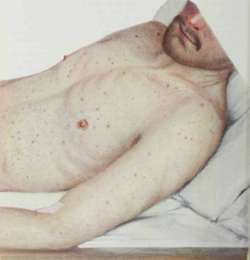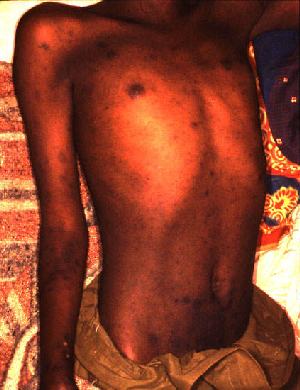Epidemic typhus

Editor-In-Chief: Prab R Tumpati, MD
Obesity, Sleep & Internal medicine
Founder, WikiMD Wellnesspedia &
W8MD medical weight loss NYC and sleep center NYC
| Epidemic typhus | |
|---|---|

| |
| Synonyms | Louse-borne typhus, camp fever, jail fever |
| Pronounce | N/A |
| Specialty | N/A |
| Symptoms | Fever, headache, rash, muscle pain |
| Complications | Pneumonia, encephalitis, septic shock |
| Onset | 1–2 weeks after exposure |
| Duration | 2–3 weeks |
| Types | N/A |
| Causes | Rickettsia prowazekii |
| Risks | Overcrowding, poor sanitation |
| Diagnosis | Serology, PCR |
| Differential diagnosis | Murine typhus, Rocky Mountain spotted fever |
| Prevention | Avoidance of lice, improved hygiene |
| Treatment | Doxycycline, chloramphenicol |
| Medication | N/A |
| Prognosis | Good with treatment, high mortality without |
| Frequency | Rare in developed countries, outbreaks in areas of conflict |
| Deaths | High mortality rate if untreated |
- A gram-negative bacterial infection caused by rickettsia prowazekii.
- It is spread by lice infected with the bacteria.
- Signs and symptoms include sudden headache, generalized muscle pain, malaise, and macular skin lesions.
- The infection may affect the central nervous system causing encephalitis.

Other names[edit]
Epidemic typhus, also called louse-borne typhus, is an uncommon disease caused by a bacteria called Rickettsia prowazekii.
Transmission[edit]
Epidemic typhus is spread to people through contact with infected body lice.
History[edit]
Though epidemic typhus was responsible for millions of deaths in previous centuries, it is now considered a rare disease.
Risk factors[edit]
- Occasionally, cases continue to occur, in areas where extreme overcrowding is common and body lice can travel from one person to another.
- In the United States, rare cases of epidemic typhus, called sylvatic typhus, can occur.
- These cases occur when people are exposed to flying squirrels and their nests.

Signs and Symptoms[edit]
Xenopsylla cheopis, the Oriental rat flea Symptoms of epidemic typhus begin within 2 weeks after contact with infected body lice. Signs and symptoms may include:
- Fever and chills
- Headache
- Rapid breathing
- Body and muscle aches
- Rash
- Cough
- Nausea
- Vomiting
- Confusion
- Brill-Zinsser disease

Clinical course[edit]
- Some people can remain infected, without symptoms, for years after they first get sick.
- Rarely, these individuals can have a relapse in disease, called Brill-Zinsser disease, months or years following their first illness.
- When this happens, it often occurs when the body’s immune system is weakened due to certain medications, old age, or illness.
- The symptoms of Brill-Zinsser disease are similar to the original infection, but are usually milder than the initial illness.

Diagnosis and Testing[edit]
- The symptoms of epidemic typhus are similar to symptoms of many other diseases. See your health care provider if you develop the symptoms listed above following travel or contact with animals.
- Tell your health care provider if you have had contact with flying squirrels or their nests.
- Your health care provider will order a blood test to look for epidemic typhus and other diseases.
- Laboratory testing and reporting of results can take several weeks. Your health care provider may start treatment before results are available.
Laboratory Confirmation[edit]
Rickettsia prowazekii can be detected via indirect immunofluorescence antibody (IFA) assay, immunohistochemistry (IHC), polymerase chain reaction (PCR) assay of blood, plasma, or tissue samples, or culture isolation. Serologic tests are the most common means of confirmation and can be used to detect either IgG or IgM antibodies. Diagnosis is typically confirmed by documenting a four-fold rise in antibody titer between acute and convalescent samples. Acute specimens are taken during the first week of illness and convalescent samples are taken 2–4 weeks later. Detectable levels of IgG or IgM antibodies generally do not appear until 7–10 days after the onset of illness.
Lab tests[edit]
Because IgG antibody titers may persist in some individuals for years after the original exposure, only demonstration of recent changes in titers between paired specimens can be considered reliable serological confirmation of an acute epidemic typhus infection. R. prowazekii antigens may cross react with those of R. typhi, and occasionally with R. rickettsii. When possible, species-specific serological assays for R. prowazekii, R. typhi, and R. rickettsii should be run in parallel. Persons with Brill-Zinsser disease generally show a rise in IgG but not IgM antibodies to R. prowazekii. IHC can be used to detect infection with typhus group Rickettsia (including R. prowazekii and R. typhi) in formalin-fixed tissue samples. PCR of whole blood or tissue can distinguish between infection with R. typhi and R. prowazekii although the sensitivity of these assays vary considerably based on the sample type, timing of sample collection, and the severity of disease. Since epidemic typhus is not common in the United States, testing is not typically available at state and local health departments. IFA, culture, and PCR can all be performed at the CDC, through submission from state health departments.
Treatment[edit]
Doxycycline is the treatment of choice for suspected cases of acute epidemic typhus and Brill-Zinsser disease in adults and children of all ages. Recommended dosages of doxycycline:
- Adults: 100 mg twice per day
- Children under 45 kg (100 lbs.): 2.2 mg/kg body weight given twice a day
Patients should be treated for at least 3 days after the fever subsides and until there is evidence of clinical improvement (usually 7–10 days). Studies have shown that even a single 200 mg dose of doxycycline for adults has been reported as effective in halting outbreaks of epidemic typhus, although some patients may relapse if not treated for the full 7–10 days. There is no information about the efficacy of antibiotic therapy in the prevention of Brill-Zinsser disease. Patients with body louse infestations should be treated with delousing gels or creams (pediculicide).

Prevention[edit]
- There is no vaccine to prevent epidemic typhus.
- Reduce your risk of getting epidemic typhus by avoiding overcrowded areas.
- Body lice thrive in areas that are overcrowded and where people aren’t able to bathe or change clothes regularly. To avoid body louse infestations:
- Bathe regularly and change into clean clothes at least once a week.
- Wash louse-infested clothing at least once a week. Machine wash and dry infested clothing and bedding using hot water (at least 130°F), and dry on high heat when possible. Clothing and items that are not washable can be dry-cleaned OR sealed in a plastic bag and stored for 2 weeks.
- Do not share clothing, beds, bedding, or towels used by a person who has body lice or is infected with typhus.
- Treat bedding, uniforms, and other clothing with permethrin. Permethrin kills lice and may provide long-lasting protection for clothing for many washings.
- Do NOT use permethrin products directly on skin. They are intended to treat clothing.
- People should avoid contact with flying squirrels and their nests.
| Proteobacteria-associated Gram-negative bacterial infections (primarily A00–A79, 001–041, 080–109) | ||||||||||||||
|---|---|---|---|---|---|---|---|---|---|---|---|---|---|---|
|
Ad. Transform your life with W8MD's Budget GLP-1 injections from $75


W8MD offers a medical weight loss program to lose weight in Philadelphia. Our physician-supervised medical weight loss provides:
- Weight loss injections in NYC (generic and brand names):
- Zepbound / Mounjaro, Wegovy / Ozempic, Saxenda
- Most insurances accepted or discounted self-pay rates. We will obtain insurance prior authorizations if needed.
- Generic GLP1 weight loss injections from $75 for the starting dose.
- Also offer prescription weight loss medications including Phentermine, Qsymia, Diethylpropion, Contrave etc.
NYC weight loss doctor appointmentsNYC weight loss doctor appointments
Start your NYC weight loss journey today at our NYC medical weight loss and Philadelphia medical weight loss clinics.
- Call 718-946-5500 to lose weight in NYC or for medical weight loss in Philadelphia 215-676-2334.
- Tags:NYC medical weight loss, Philadelphia lose weight Zepbound NYC, Budget GLP1 weight loss injections, Wegovy Philadelphia, Wegovy NYC, Philadelphia medical weight loss, Brookly weight loss and Wegovy NYC
|
WikiMD's Wellness Encyclopedia |
| Let Food Be Thy Medicine Medicine Thy Food - Hippocrates |
Medical Disclaimer: WikiMD is not a substitute for professional medical advice. The information on WikiMD is provided as an information resource only, may be incorrect, outdated or misleading, and is not to be used or relied on for any diagnostic or treatment purposes. Please consult your health care provider before making any healthcare decisions or for guidance about a specific medical condition. WikiMD expressly disclaims responsibility, and shall have no liability, for any damages, loss, injury, or liability whatsoever suffered as a result of your reliance on the information contained in this site. By visiting this site you agree to the foregoing terms and conditions, which may from time to time be changed or supplemented by WikiMD. If you do not agree to the foregoing terms and conditions, you should not enter or use this site. See full disclaimer.
Credits:Most images are courtesy of Wikimedia commons, and templates, categories Wikipedia, licensed under CC BY SA or similar.
Translate this page: - East Asian
中文,
日本,
한국어,
South Asian
हिन्दी,
தமிழ்,
తెలుగు,
Urdu,
ಕನ್ನಡ,
Southeast Asian
Indonesian,
Vietnamese,
Thai,
မြန်မာဘာသာ,
বাংলা
European
español,
Deutsch,
français,
Greek,
português do Brasil,
polski,
română,
русский,
Nederlands,
norsk,
svenska,
suomi,
Italian
Middle Eastern & African
عربى,
Turkish,
Persian,
Hebrew,
Afrikaans,
isiZulu,
Kiswahili,
Other
Bulgarian,
Hungarian,
Czech,
Swedish,
മലയാളം,
मराठी,
ਪੰਜਾਬੀ,
ગુજરાતી,
Portuguese,
Ukrainian


